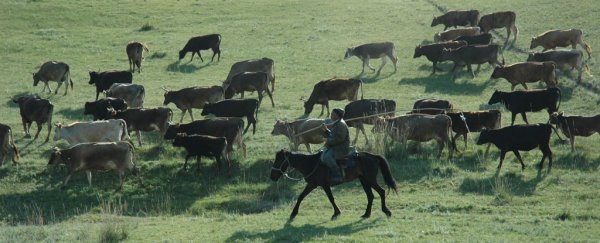The fabled Silk Road may be one of the most famous and important trade networks in Earth's history, but a new study suggests that this ancient web of paths spanning Asia had its roots in trails dating back much further than anybody realised.
The Silk Road is often taken to mean the paths linking major cities and trade hubs between Asia and Europe from around 200 BC to the 14th century. But new research suggests that the people who first established the famous routes had far humbler origins than historians once assumed.
"The mistake that is often made when talking of the Silk Roads is seeing it as something that was launched at a particular point in time by powerful states," anthropologist Michael Frachetti from Washington University in St. Louis told International Business Times, "when actually it was a dynamic and flexible process that gradually emerged over time."
Historical analyses of the Silk Road have centred on the primary trade corridors linking major settlements and trade hubs, tracing the routes by calculating the shortest 'least-cost' paths between each point.
According to Frachetti, while that approach works for lowland areas where direct routes are possible, it doesn't actually reflect the way that farmers and traders would have moved their herds through rugged mountain regions.
In his hypothesis, these nomads would have been the actual builders of what later became the Silk Road, as they lay down the foundations of its paths when herding animals over the land almost 5,000 years ago.
"The locations of ancient cities, towns, shrines, and caravan stops have long illustrated key points of interaction along this vast network, but defining its many routes has been far more elusive," Frachetti explains in a press release.
"As a result, there is little known of the detailed pathways used for millennia by merchants, monks, and pilgrims to navigate and interact across the highlands of Inner Asia."
To map out the paths that farmers and traders would have most likely travelled in mountainous regions, Frachetti's team developed a computer model to simulate herding mobility at elevations of 750 metres (2,461 feet) to 4,000 metres (13,123 feet) – incorporating seasonal windows when it would have been practical and safe to transport large herds of animals through the Asian highlands.
"Aggregating 500 iterations of the model reveals a high-resolution flow network that simulates how centuries of seasonal nomadic herding could shape discrete routes of connectivity across the mountains of Asia," the researchers explain in their paper.
The model was generated independently of data plotting the location of Silk Road settlements, but when the team compared its herd flow chart to the Silk Road geography, 74.4 percent of highland sites fell on the paths their model predicted.
The researchers aren't claiming that their model is proof that the Silk Road as we know it existed thousands of years earlier than historians indicate.
But they say that it's probable – given what we know of these ancient herder societies – that the later Silk Road was largely based on the paths that the nomads first discovered and travelled millennia beforehand.
"Archaeology documents the development of mountain-herding economies in highland Asia as early as 3000 BC," says Frachetti, "and we argue that centuries of ecologically strategic mobility on the part of these herders etched the foundational routes and geography of ancient trans-Asian trade networks."
The findings don't just help us understand more about the history-making processes that forged one of the most famous road systems in existence.
According to the researchers, studying how the Silk Road enabled the exchange of culture and commerce between different peoples could also tell us a thing or two about social forces in the world today.
"What our study shows is that strong urban centres of power are not necessarily needed to create these very flexible and economically important networks … but that they can be created by small, non-urban communities," Frachetti told Léa Surugue at International Business Times.
"[T]he Silk Roads were open and flexible networks, promoting an ancient form of globalisation that became the engine of broad civilisation – processes that contrast with what the isolationist moves we see occurring at present."
The findings are reported in Nature.
